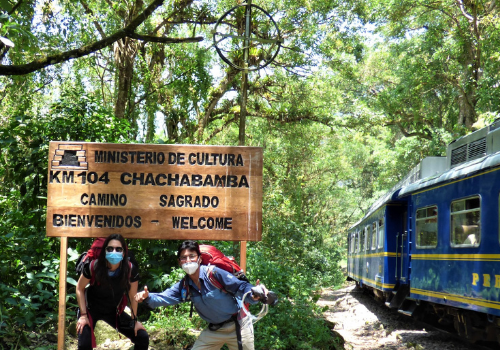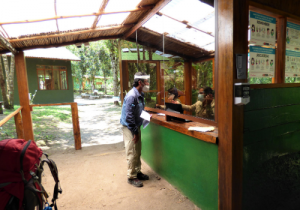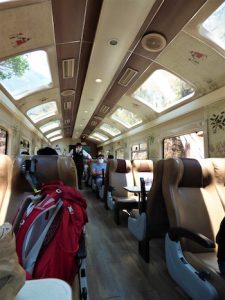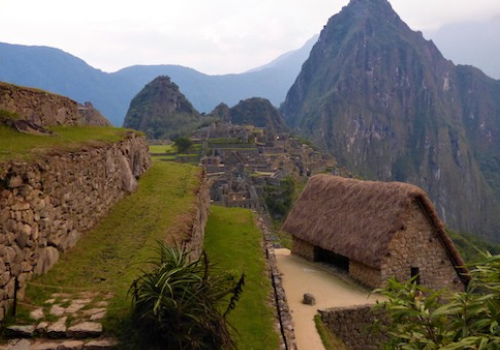By Gina Allman of ATTA Business Member, Amazonas Explorer
On November 1st the government of Peru opened up its international borders and Machu Picchu for the first time since March 16th. A group of us at Amazonas Explorer, a tour operator based out of Cusco, decided we needed to go on a scouting mission to understand what traveling under the new safety protocols is like. According to the state’s regulations, only 50% capacity is permitted for all trains and busses to Machu Picchu. Machu Picchu’s capacity is currently set at 30% which limits entry to only 675 people per day, creating a pretty exclusive experience for one of the most visited historical sites in the world.

Machu Picchu had so many false reopening’s that by the time we knew for sure it was actually happening, and my flights were purchased, all tickets into Machu Picchu were sold out. Luckily, there were a couple of tickets and corresponding trains to hike into Machu Picchu from KM 104. For those of you who don’t know what KM 104 is, it’s a point in the Urubamba River Valley where you can access the Inca Trail by train, and ascend the ancient trail to Machu Picchu. This route passes through the ruins of Wiñay Wayna and brings you to the ancient Sun Gate (Inti Punku) where 3-4 hours of lunging up the ancient Inca Road is paid off with National Geographic worthy, panoramic views of Machu Picchu. The locals say you have to give a piece of yourself to the mountain (or the Apu’s) to be worthy of entrance, the KM 104 hike ensures an offering is made.
 Our day started with a train ride from Ollantaytambo to KM 104. To enter the Peru Rail train station, each person must wash their hands, have their temperatures taken, and sanitize their hands with alcohol. Entry is not permitted without a face shield, facemask, and a sworn statement of health that each passenger must sign. While waiting to board the train, the ground was clearly marked where each passenger should stand to maintain social distance. All train attendants were also wearing both facemasks and face shields.
Our day started with a train ride from Ollantaytambo to KM 104. To enter the Peru Rail train station, each person must wash their hands, have their temperatures taken, and sanitize their hands with alcohol. Entry is not permitted without a face shield, facemask, and a sworn statement of health that each passenger must sign. While waiting to board the train, the ground was clearly marked where each passenger should stand to maintain social distance. All train attendants were also wearing both facemasks and face shields.
Our group boarded the train, with a train attendant encouraging us to sanitize our hands again, on one of the many gel dispensers hanging on the walls of the passenger car. The seating on the train consists of four seats, facing each other, that surround a table. To meet the safety protocols every other seat is blocked off, meaning each table has two people sitting around it, diagonally, creating adequate distance between any two travelers. This is pretty nice, as it provided an extra seat for backpacks, cameras and hiking accouterments. The train chugged along for around 50 minutes as we watched the high Andean altiplano turn into the cloud forest.
 As KM 104 approached the train attendant lead us to the rear door, where we could calmly disembark from the train to the Inca Trail control point. The attendant cheerfully told us how happy he was to be working again and how good it felt to have his uniform on again after months of not being able to wear it. He then quietly informed us that there was one other group, and if we went through the control point first, we most likely wouldn’t see them for the entire hike. As the train slowly came to a full stop, he wished us luck and with a huge smile, he helped us climb off the train.
As KM 104 approached the train attendant lead us to the rear door, where we could calmly disembark from the train to the Inca Trail control point. The attendant cheerfully told us how happy he was to be working again and how good it felt to have his uniform on again after months of not being able to wear it. He then quietly informed us that there was one other group, and if we went through the control point first, we most likely wouldn’t see them for the entire hike. As the train slowly came to a full stop, he wished us luck and with a huge smile, he helped us climb off the train.
In the distance, on the shores of the Urubamba, we could see two other ruins, as we made our way to the control point, crossing a freshly restored bridge that hung proudly over a thirsty river, low after an untypically dry October. At the control point, they made sure we maintained distance as they took our temperatures and pumped gel onto each of our hands. One by one we showed our permits while the gatekeeper insisted the group behind us wait outside the gate until we completed our entry. Upon entry, we were permitted to remove our faces shields before crossing the shoreside ruins of Chachabamba, that marked the beginning of our ascent to Machu Picchu.
The more we climbed the cooler it got, and we watched with awe at the magnitude of the Andes that seem to shoot out from the valley floor below. As we walked, we noticed several parts where the cloud forest had started reclaiming the ancient path after almost 9 months with no use. Stopping at a waterfall to cool down and refill our waters we commented amongst ourselves how we haven’t seen the group behind us, nor one other person so far. Arriving to Wiñay Wayna, we had the complex all to ourselves. Taking full advantage, we spent about 45 minutes exploring the empty ruins, absorbing every ounce of the solitude and the magnitude of the scene before us.

Needing to move on, we continued the relentless ascent to the Sun Gate, or the Inti Punku, with each Inca step becoming steeper and steeper as we arrived to the top. Stepping over the edge and looking out over the ancient city of Machu Picchu we didn’t see one other person. Nobody spoke, nobody took photos, as the group was speechless with emotion, thinking about the tragedy that created this scene and the extreme privilege we had to be at that place, at that moment. Here we were, at one of the most popular “man-made wonders of the world”, staring down at an empty citadel. In this moment you have fleeting glimpses of what it must have been like for Hiram Bingham to stumble upon the ancient city, overgrown, silent, and empty.
